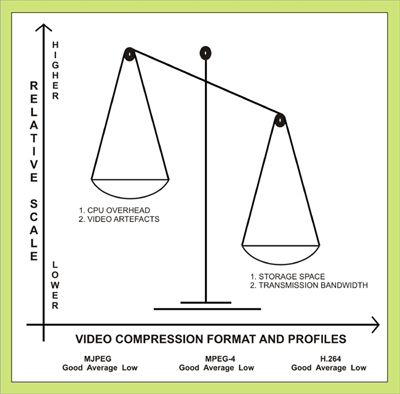Video Compression is the term used to define a method for reducing the data used to encode digital video content. This reduction in data translates to benefits such as smaller storage requirements and lower transmission bandwidth requirements, for a clip of video content.
Video compression typically involves an elision of information not considered critical to the viewing of the video content, and an effective video compression codec (format) is one that delivers the benefits mentioned above: without a significant degradation in the visual experience of the video content, post-compression, and without requiring significant hardware overhead to achieve the compression. Even within a particular video compression codec, there are various levels of compression that can be applied (so called profiles); and the more aggressive the compression, the greater the savings in storage space and transmission bandwidth, but the lower the quality of the compressed video [as manifested in visual artefacts – blockiness, pixelated edges, blurring, rings – that appear in the video] and the greater the computing power required.
Motion JPEG (M-JPEG): Originally developed by JPEG (Joint Photographic Experts Group) for multimedia PC applications, M-JPEG is now used by many digital video capture devices. In M-JPEG, each video frame is separately compressed as a JPEG image.MPEG-4 Part 2: Developed by MPEG (Motion Pictures Expert Group), it is a successor MPEG standards such as MPEG-1 and MPEG-2, and offers higher compression factors.H.264 (MPEG-4 Part 10 or MPEG-4 AVC): This is a standard jointly developed and maintained by ITU-T (Telecommunication Standardisation Sector) and MPEG, and hence the fact that it is referred by multiple acronyms.

There are two approaches to achieving video compression, viz. intra-frame and inter-frame. Intra-frame compression uses the current video frame for compression: essentially image compression. Inter-frame compression uses one or more preceding and/or succeeding frames in a sequence, to compress the contents of the current frame. An example of intra-frame compression is the Motion JPEG (M-JPEG) standard. The MPEG-1 (CD, VCD), MPEG-2 (DVD), MPEG-4, and H.264 standards are examples of inter-frame compression.The popular video compression standards in the IP video surveillance market are M-JPEG, MPEG-4, and H.264.
|
Comparison of Video Compression Standards
There is a constant improvement in video compression factors, thanks to new techniques and technology, and some new formats in the horizon are H.265 and VP8.
- H.265 is still in the process of being formulated, and aims to achieve a 25% improvement in the compression factor while lowering computational overhead by 50%: for the same perceived video quality.
- VP8 is a codec from On2 Technologies (which recently agreed to be acquired by Google), who claims that the codec brings bandwidth savings and uses less data than H.264: to the extent of 40%. There is currently a fight over the standard to be chosen for Web video (fuelled by the upcoming HTML5 standard), and VP8 is slugging it out with H.264 and Ogg Theora.



